23
By the end of this chapter, you will be able to:
- Prepare a works cited page in MLA Style. (GEO 2; SLO 2, 5)
- Create bibliographic entries for a works-cited list. (GEO 2; SLO 2, 5)
- Use MLA-Style in-text citations. (GEO 2; SLO 2, 5)
Works Cited Page
The Works Cited page is the official name for the bibliography in MLA Style. It lists all of the sources you used in your paper and is placed at the end of the paper on a new numbered page. The sources listed on that page and the ones you cite within the text must align exactly.

1. Margins, header, font, and spacing should be the same as the rest of your essay.
2. Page: Start a new page for your Works Cited. Don’t start it on the same page your essay ends. You may make a new file, but it’s easier to insert a Page Break.
3. Title: Type and center the words “Works Cited” in plain text.
4. Capitalization: Capitalize the first letter of each word in a title, except for small words like articles (a, an, the) and prepositions unless it is the first word of a title: Gone with the Wind, The Art of War, There Is Nothing Left to Lose.
5. Indentation: Use hanging indents. This means that the first line of each citation should NOT be indented, and every line after it is indented by half an inch. To do this, go to the paragraph menu, and under Indentation, select Special: Hanging by 0.5 inches.
6. Order: List the sources in alphabetical order by the authors’ last names. Ignore “A,” “And,” and “The” when alphabetizing by title if an author is not listed.
7. Web address URLs: For every source that comes from the Internet (the only exception is Databases), you will need to put the full Web address. To undo a hyperlink, right-click on the URL, then select Remove Hyperlink from the drop-down menu that appears.
8. Finally, make sure all the sources listed on your Works Cited are indeed used in your essay, and likewise make sure every source referenced in your essay has a citation on the Works Cited page.
Sample Works Cited page:

MLA-Style Citations

Citations include all the necessary information about sources that you cite in your essay. They are all listed together on the Works Cited page.
Cite simple traits shared by most works. The traits common to most works – authors, titles, dates of origin – should be included in every applicable citation in the same order.
There is often more than one correct way to document a source. For example, whether you include the title, director, or an actor’s name first in a citation for a film might depend on whether you were looking at the film as a whole, the creation of the film, or a specific performance in it.
Make your documentation useful to readers. The point of providing documentation is to give credit to original sources, so it’s important that your readers can locate them in order to draw their own conclusions about the argument, analysis, or point you presented.
Core Elements of Citations
1. Author.
Present the author’s last name first, then their first name, with a comma between. If there are multiple authors, include all their names in the order they appear, but only the first author’s name should be in the reverse order. Completely spell out the names of corporate authors.
2. “Title of Source.”
This should be the name of the article, entry, chapter, Web page, song, scene, or episode you are using. These types of titles (works that are part of a larger unit) should be written in quotation marks. When you are using an entire unit – such as a book or a film – in your essay, you can skip this.
3. Title of Container,
The container is the larger work that your source in #2 came from, such as the periodical, encyclopedia, book, Web site, album, film, or series. These types of titles should be written in italics. Sometimes, you will use sources with two containers, such as print book that you read online, an article from a journal that you accessed with a database, or a film or TV show that you watched through a streaming service.
4. Other Contributors,
If your source has other contributors, then you will need to write “edited, translated, interview, illustrated, narrated, adapted, produced, directed, adapted, or performance by” then the person’s first and last name.
5. Version,
If you are using a source with specific versions, such as a revised edition of a classic work, a version of the Bible, or an extended or director’s cut edition of a movie, you will need to designate in your citation.
6. Number,
Some sources have volume numbers (such as encyclopedias), issue numbers (such as magazines), or both (such as journals).
7. Publisher,
The publisher is the entity primarily responsible for producing the source and making it available to the public. For example, books are published by publishing houses, periodicals are published by media companies, movies are published by production companies, TV shows are published by TV channels, and Web sites are published by whomever owns their copyright.
8. Publication Date,
When you are using a book or film, you only need to put the year of publication. Articles and TV shows, however, require the day, month, and year of their original publication. For Web pages, put as much information about the date as it gives you, even if it’s just a year.
9. Location.
For books and other print sources, the location is the page (p. #) or pages (pp. #). For Web sites, the location is the URL Web address. When you do include a URL, you may need to include the date you accessed it as well.
10. Other Elements
If your source comes from the Web, then after you finish the citation, you should write the word “Accessed” and the date you accessed it. Some less common sources, like classic literature, artwork, graphics, oral presentations, court cases, and bills or laws also require additional elements.
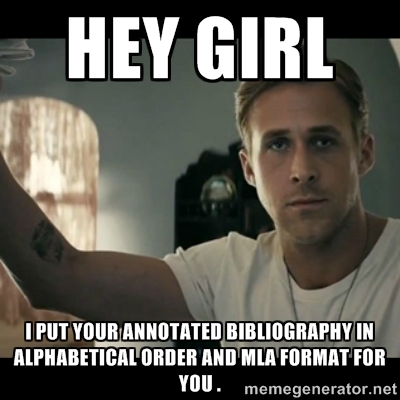
Citation Examples
1. Authors
Lum, P. Andrea. “Computed Tomography.” World Book, Yale University Press, 2000, pp.
193-220.
Gillespie, Paula, Naomi Baron, and Neal Lerner. “Safe Spaces.” The Allyn and Bacon
Guide to Peer Tutoring, Allyn, 2000, p. 129.
British Monetary Fund. “Positive Examples of McDonald’s Commercialization in Asia.”
In Defense of Globalization, Oxford Press, 2004, pp. 60-62.
2. Articles and Web pages
Maumill, Sarah. “The Great Debate.” CNN Politics, Cable News Network, 13 July 2009,
http://www.cnn.com/politics/the-great-debate/18095.html. Accessed 12 Jan.
2010.
Tanner, Randi. “Patent Pamphleteer.” Scientific American, American Science Academy,
Dec. 2001, http://thescientificamerican.org/Dec-2001/patent-phamp/. Accessed
12 Jan. 2010.
Torres, Vicky. “Watching the Fire.” The Sable Archives, 12 Jan. 2010,
http://www.thesablearchives.com/watchingthefire/. Accessed 16 Jan. 2010.
“History of Alexander the Great.” Histology,
http://www.histology.org/emperors/alexander. Accessed 12 Jan. 2010.
3. Videos, TV shows, and Films
Tyson, Neil deGrasse. “Hiding in the Light.” YouTube, uploaded by Cosmos: A
Space Odyssey, 6 April 2014, https://www.youtube.com/watch?v=
EfcKYQoIDgw. Accessed 16 July 2013.
“The Blessing Way.” The X-Files, created by Chris Carter, performances by David
Duchovny and Gillian Anderson, season 3, episode 1, Fox, 22 Sept. 1995.
Pride and Prejudice, directed by Andrew Davies, performances by Keira Knightley
and Matthew Macfadyen, Focus Features, 2007.
The Usual Suspects, directed by Bryan Singer, performance by Kevin Spacey, Polygram,
1995. Netflix, https://www.netflix.com/ %2Fbrowse. Accessed 20 Nov. 2012.
4. Databases
Bronte, Anne. “Mementos.” Poems by Currer, Ellis, and Acton Bell, London, 1846, pp. 4-
6. Google Books, https://books.google.com/books?id=AnEc5-zIoB8C.
Accessed 18 Sept 2009.
Haber, Joel. “A Cyberbullying Protection Plan.” Time Magazine, vol. 25, no. 4, March
2011, pp. 32-37. Issues and Controversies, doi: 38903457-34580949305.
Accessed 6 June 2011.
La Faye, Dierdre. “Culture and Context.” How to Write About Jane Austen, edited by
Harold Bloom, Random House, 1984, pp.69-88. Bloom’s Literary eBook
Collection, http://0-ebooks.infobaselearning.com.libcat.sanjac.edu/View.aspx
?ISBN=9781438112671&InstID=4036. Accessed 20 June 2009.
5. Contributors
Mitchell, Joseph. “The Bottom of the Harbor.” American Sea Writing, edited by John
Williams, Library of America, 2000, pp. 584-608.
6. Versions and Numbers
The Bible, Authorized King James Version, Oxford University Press, 1998.
Welleck, Renee. “Marxist Theory.” A History of Modern Criticism, vol. 5, Yale University
Press, 1986, pp. 625-628.
Stafford, Rhonda. “Catching the Wave.” The Daily Standard Celina CA, no. 26, Cox
Media, Nov. 2008.
Kafka, Ben. “Redefining Reading: The Impact of Digital Communications Media.” PMLA,
vol. 128, no. 1, Jan. 2013, pp. 193-200.
Multiple-Container Sources

Here’s where things become a little more complicated. Sometimes, a source will appear in a first container that is then included in a second container. For example, let’s say you want to cite an essay that originally appeared in a book (first container) but which you accessed from an online database (a second container). This source has two containers. The information would be cited like this:
Author(s). “Title of Source.” Title of First Container, Other Contributors, Version, Number, Publisher, Publication Date, Location. Title of Second Container, Location. Accessed date.
To help you see how this second container works, here is an example of the same essay that was found in print and through an online source.
Ellison, Ralph. “The World and the Jug.” The Collected Essays of Ralph Ellison, edited
by John Callahan, Modern Library, 2003, pp. 155–88.
Ellison, Ralph. “The World and the Jug.” The Collected Essays of Ralph Ellison, edited by
John Callahan, Modern Library, 2003, pp. 155–88. Google Books,
books.google.com/books?id=GT3oSgZKvQoC&printsec=frontcover&dq=
collected+essays&hl=en&sa=X&ved=0ahUKEwiBmJjQz6LMAhWis4MK
HcMzCNEQ6AEIMTAD#v=onepage&q= collected%20essays&f=false.
Accessed 26 June 2020.
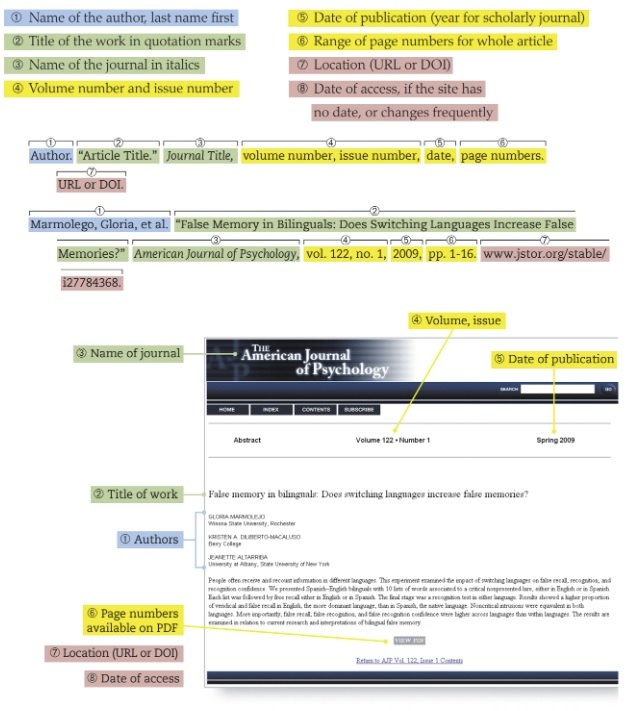
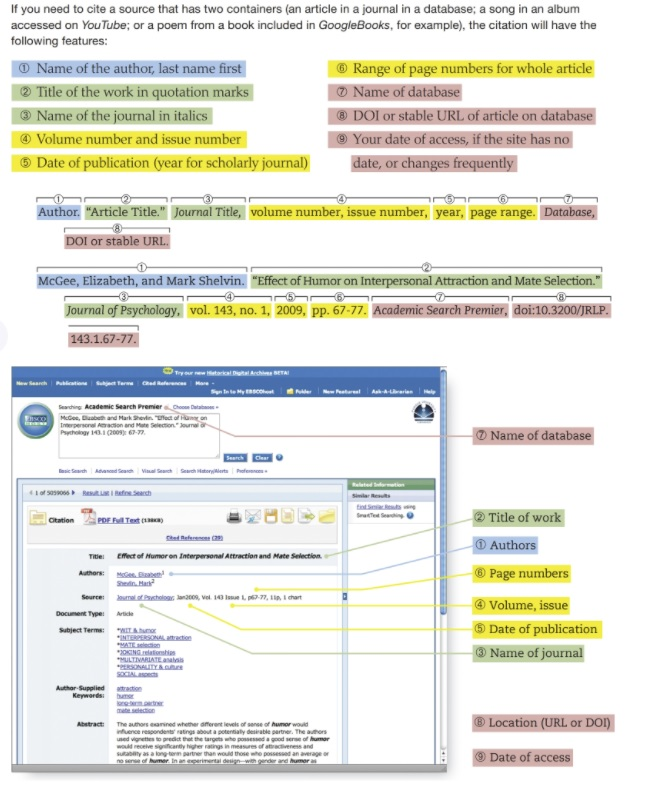
In-Text Citations
When you use the words or ideas of another person in your paper, you must document the source within the text of the paper as well as on the Works Cited page. Whether you quote or paraphrase the source, you must include an in-text citation that:
1) Clearly points to the source on the Works Cited page.
2) Identifies the location of the borrowed information.
Referring to the works of others in your own essay is done through In-Text Citations. MLA Style uses a type of in-text citations known as Parenthetical References, because they are a reference to the source’s bibliographical citation that appears in parentheses at the end of a sentence.
Author-Page Style
MLA follows the author-page style of formatting. This is pretty simple. First, type the author’s last name. Then type the page number from which you are quoting or paraphrasing. Next, put them together (with a space in between) in a little parenthesis sandwich at the end of your sentence. The period goes after the parenthetical reference. Think of the period as a door shutting all the info that goes together into its own room.
Example
This tells readers that this quote comes from page 2 of a work written by an author with the last name of “White”. If the reader wants more information, they can flip to the Works Cited page and find “White”.
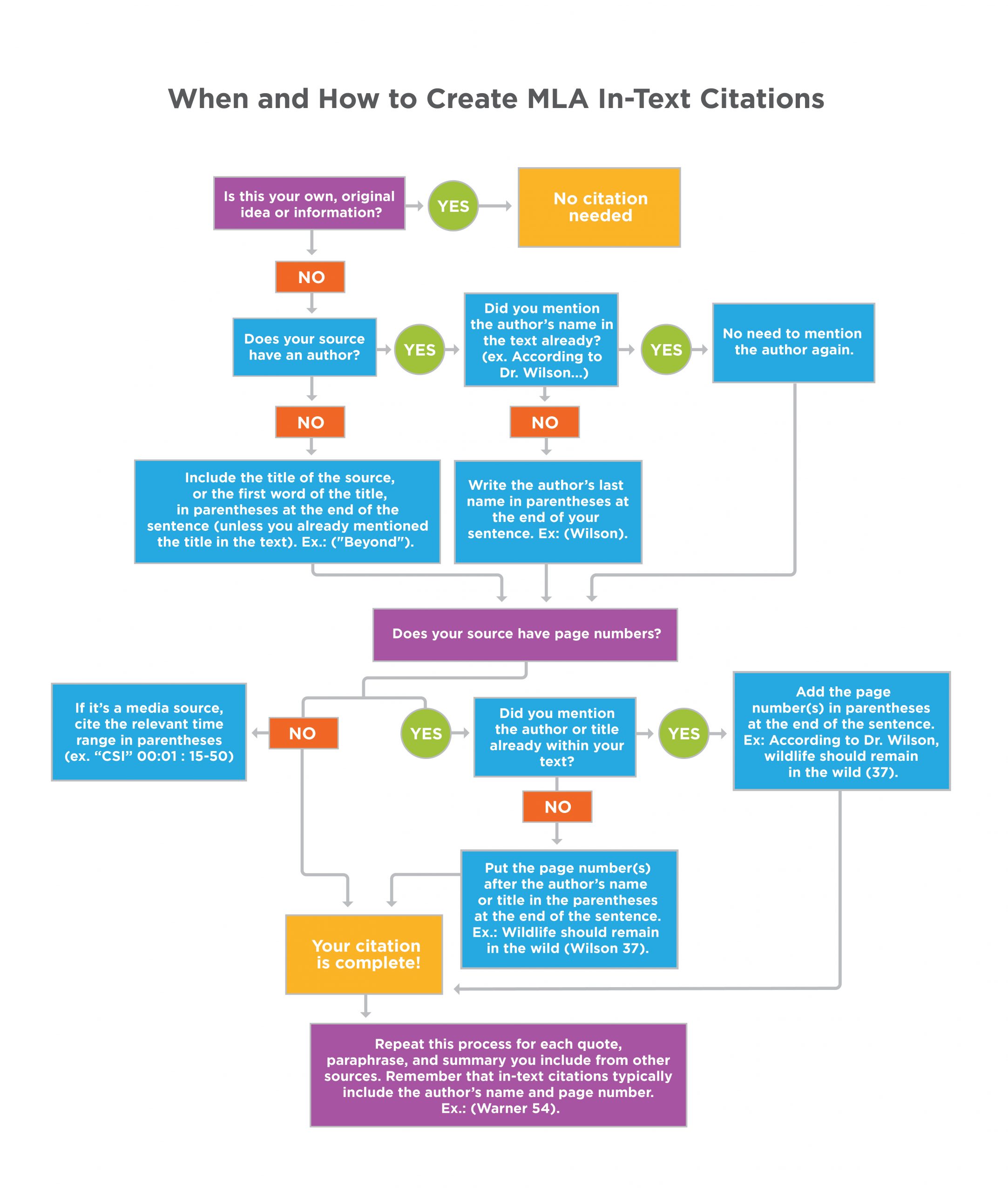
Exceptions to the Author-Page Style Rule
1. More Than One Author: If a source has two or three authors, include each of their last names in the order they appear in the bibliographical citation.
Example: (Smith, Green, and White 55).
2. Four or More Authors: Just write the first author’s last name and “et al.”, which means “and others.”
Example: (Smith et al. 55)
3. Corporate Author: Use the name of the organization instead of the author’s last name. You may use an acronym, if an organization has one, or abbreviations.
Examples: (U.S. Dept. of Labor 33), (HBO 11)
4. No Author(s): Write the title of the work, or a shortened version of it, instead. Remember to use quotation marks or italics.
Examples: (“The Basics of Chaos Theory”), (The Matrix)
5. No Page Number(s): Don’t include any – just skip it and move on!
6. Multiple Works by the Same Author: If you have more than one citation on your Works Cited by the same author, put the author’s last name and the first word of the title (disregarding a, an, and the) divided by a comma.
Examples: (Austen, Emma 29), (Austen, Persuasion 135), (Austen, Mansfield Park 12)
7. Multiple Sources in One Sentence: If you use more than one source in the same sentence, put both sources in the same parenthetical reference, separated by a semicolon. Put the source with the information you used first in the sentence first in the parenthetical reference.
Examples: (Gregory 39; Sheffield 29), (“Minefield” 32; A Brief History of Time 344), (Dystopia 383; Clark and Lewis 82)

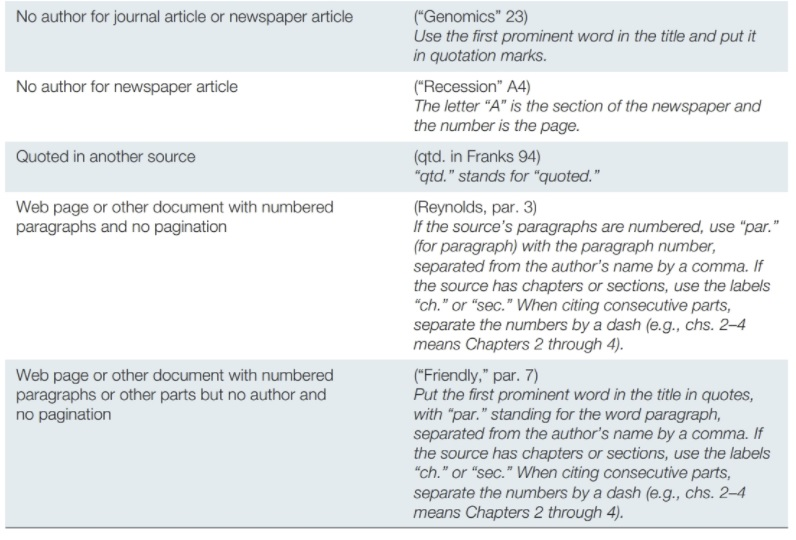
In MLA Style, the bibliography (list of sources used) is referred to as the Works Cited page.
The style recommended by the Modern Language Association (MLA) for preparing scholarly manuscripts and student research papers. It concerns itself with the mechanics of writing, such as punctuation, quotation, and, especially, documentation of sources.
A collection of information that supplies material for research purposes.
A reference to a source used in a scholarly work that contains the relevant information about that source's publication.
The creator of a work.
The name of a source. In MLA Style, titles are written in upcase, capitalizing the first letter of each word.
The larger work that contains a source.
A person, other than the author, that contributed to a work's creation or publication.
The different forms of a source that may exist.
1. A work that forms part of a series, such as an encyclopedia.
2. A number accounting for the years a publication has been in circulation.
The individual editions of a publication, such as a newspaper or magazine.
The entity primarily responsible for producing the source and making it available to the public.
The brief form of a source reference that included the text of an essay.
A citation style in which partial citations that reference a bibliographical citation are enclosed within parentheses and embedded in the text, either within or after a sentence.
